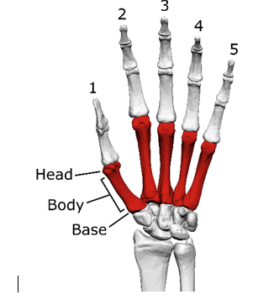- Reference Number: HEY1289/2022
- Departments: Orthopaedics, Physiotherapy
- Last Updated: 30 September 2022
Introduction
This leaflet has been produced to give you general information. Most of your questions should be answered by this leaflet. It is not intended to replace the discussion between you and the healthcare team, but may act as a starting point for discussion. If after reading it you have any concerns or require further explanation, please discuss this with a member of the healthcare team.
What is a metacarpal bone fracture?

The metacarpals are the long, thin bones between the wrist bones and finger bones. There are 5 metacarpals, one for the thumb and one for each of the fingers.
A fracture is a break to the bone. Your fracture can be described as simple, stable or undisplaced, which means there is a clean break, but the pieces of bone are in the correct place and are unlikely to move out of place.
How should it be treated?
This injury can be treated in a number of ways depending on the site of the fracture, whether at the head, body or base.
- You may have neighbour strapping for 3 weeks, the strapping will provide the bone the stability it needs to heal and will help reduce any pain you may experience. Extra strapping can be purchased from your local chemist and should be replaced when it becomes wet or worn. Please ensure it is applied above and below the finger joints, so that it does not restrict movement as this will cause stiffness.
- You may have also been given a wrist splint this can also be used for the same length of time.
- You may have a half cast/back slab which is bandaged on. This can be cut off down the soft bandage after an amount of time advised by the healthcare team.
To manage your pain, we advise that you regularly take simple pain relief, which can be bought over the counter. If you have allergies or conditions, which prevent the use of pain-relieving or anti-inflammatory medication, please seek advice from your doctor or a pharmacist.
It is important to note that smoking will delay the healing process and so should be minimised if at all possible.
What should I do in the first few days?
Complete rest is not advisable. Whilst in the strapping, it is important that you try to use your wrist and hand normally when doing everyday tasks like washing, dressing and eating.
If you are in a cast, it is important to move all joints/fingers not contained within the cast. Once you have removed the cast, it is normal for the hand to feel stiff and the skin to be dry. Normal hand washing and the exercises below will help with this.
Exercising the hand early is very important to prevent stiffness at the finger/thumb joints. The following exercises should each be repeated 10 times and completed every 2 to 3 hours. Support your elbow on the table with your wrist straight.
1. Finger and thumb extension
Straighten and stretch your fingers and thumb as straight and wide as you can. Hold for 10 to 20 seconds.

2. Hook
Bend your fingers and thumb at the small joints. Hold for 10 to 20 seconds.

3. Full Fist
Bend your fingers and knuckles to make a fist as tightly as you can. Hold for 10 to 20 seconds.

4. Opposition
Take the tip of your thumb across to the tip of your little finger, then down the little finger. Hold the stretch for 10 to 20 seconds.

Swelling and pain
Swelling and pain is a normal reaction following any fracture and may persist for 4 to 6 weeks or on occasions longer.
The following will help with this:
- Elevating the hand, especially at night on pillows.
- Ice – massage with an ice cube. Remembering to keep it moving.
- Massage along the hand towards the wrist.
- Exercises
- Over the counter pain relief as described earlier.
You may notice a visible lump at the fracture site and this is normal. This lump represents the bone healing process and tends to decrease over several months.
When can I drive again?
You may not be insured to drive whilst the strapping or splint is in place. It is always good to check with your insurance company.
It may be safe to return to driving when:
- You are no longer using the strapping
- You can comfortably grip the steering wheel, move the gear stick, pull up the hand brake and activate the indicators
- You can perform an emergency stop
What about work and sport?
If you have a job with light or clerical duties, you can work as soon as you feel comfortable.
Heavy manual work is best avoided until 6 weeks after your injury.
Full contact sport should also be avoided for at least 6 weeks
When should I call for a PIFU appointment?
The fracture usually heals well with a gradual return to normal movement and grip strength.
You should initiate a PIFU appointment:
- If you are in a full cast, there are no soft areas.
- If you are struggling to make a full fist or reach the base of your little finger with your thumb tip at 3 weeks following your injury or after you remove your cast.
- If you notice the position of a finger or the thumb appears to have changed, such as being at an angle or rotated, especially during movement.
- If you feel your movement or function is worsening.
- If you feel your pain or swelling worsens.
- If you are struggling to return to your usual work or hobbies after 6 weeks.
Should you require further advice on the issues contained in this leaflet or wish to initiate a PIFU appointment, please do not hesitate to contact the Physiotherapy Department on tel: 01482 624880.
General Advice and Consent
Most of your questions should have been answered by this leaflet, but remember that this is only a starting point for discussion with the healthcare team.
Consent to treatment
Before any doctor, nurse or therapist examines or treats you, they must seek your consent or permission. In order to make a decision, you need to have information from health professionals about the treatment or investigation which is being offered to you. You should always ask them more questions if you do not understand or if you want more information.
The information you receive should be about your condition, the alternatives available to you, and whether it carries risks as well as the benefits. What is important is that your consent is genuine or valid. That means:
- you must be able to give your consent
- you must be given enough information to enable you to make a decision
- you must be acting under your own free will and not under the strong influence of another person
Information about you
We collect and use your information to provide you with care and treatment. As part of your care, information about you will be shared between members of a healthcare team, some of whom you may not meet. Your information may also be used to help train staff, to check the quality of our care, to manage and plan the health service, and to help with research. Wherever possible we use anonymous data.
We may pass on relevant information to other health organisations that provide you with care. All information is treated as strictly confidential and is not given to anyone who does not need it. If you have any concerns please ask your doctor, or the person caring for you.
Under the General Data Protection Regulation and the Data Protection Act 2018 we are responsible for maintaining the confidentiality of any information we hold about you. For further information visit the following page: Confidential Information about You.
If you or your carer needs information about your health and wellbeing and about your care and treatment in a different format, such as large print, braille or audio, due to disability, impairment or sensory loss, please advise a member of staff and this can be arranged.

